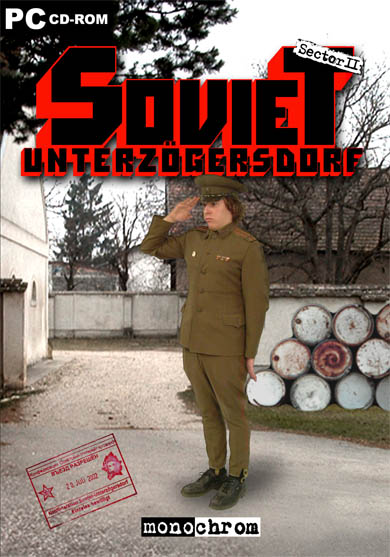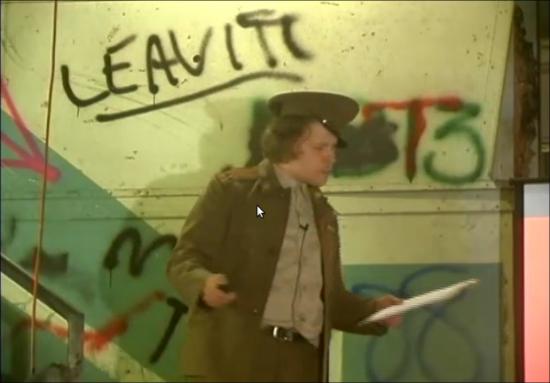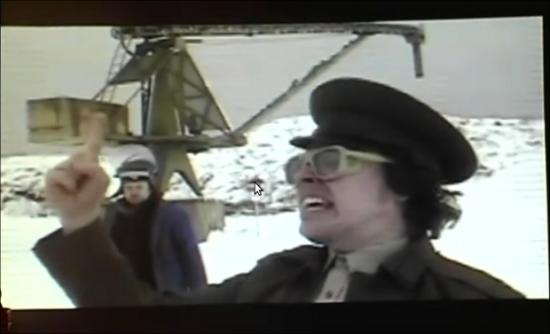



Above image taken by Scott Beale, Laughing Squid.
Marc Da Costa interviews the ever dynamic Johannes Grenzfurthner, founder of monochrom. This is the first of three interviews, where he talks about the project ‘Soviet Unterzoegersdorf’; the fake history of the “last existing appanage republic of the USSR”. Created to discuss topics such as the theoretical problems of historiography, the concept of the “socialist utopia” and the political struggles of postwar Europe. In March 2009 Monochrom presented ‘Soviet Unterzoegersdorf: Sector II’. The game features special guest appearances of Cory Doctorow, Bruce Sterling, Jello Biafra, Jason Scott, Bre Pettis and MC Frontalot.
Since 1993, the Monochrom members have devoted themselves to the grey zones where systems intersect: the art (market), politics, economics, pop, gaiety, vanity, good clean fanaticism, crisis, language, culture, self-content, identity, utopia, mania and despair. The technique underlying Monochrom’s work is that of being and working in the fields of Pop/avant-garde, theory/reflection, interventionism/politics, gaiety/lust/tragedy, (self-)configuration/mystification. The project Monochrom pushes into and beyond these fields is, ‘networking’ events, people, possibilities, material, impetus and identities.” (Zdenka Badovinac, Moderna Galerija Ljubljana)
Grenzfurthner has collaborated with groups such as ubermorgen, Billboard Liberation Front, Esel and Mego (label). Grenzfurthner writes for various online/print magazines and radio stations (e.g. ORF, Telepolis, Boing Boing). Grenzfurthner has served on a number of art juries (e.g. Steirischer Herbst, Graz). He holds a professorship for art theory and art practice at the University of Applied Sciences, Graz, Austria and is a lecturer at University of Arts and Industrial Design in Linz, Austria.
Recurring topics in Johannes Grenzfurthner’s artistic and textual work are: contemporary art, activism, performance, humour, philosophy, sex, communism, postmodernism, media theory, cultural studies, popular culture studies, science fiction, and the debate about copyright.
The ‘Soviet Unterzoegersdorf’, a game created by monochrom, is described as being at once the “last existing appendage republic of the USSR” and located inside the Republic of Austria. Could you speak a bit about the project and its background?
From a conceptual background we have to state that we have been occupied with the construction, analysis and reflection of alternative worlds for quite a long time. A lot of our projects are treating this field partly as a discussion with concepts deriving from popular culture, science and philosophy, and partly as a direct reference to science fiction and fantasy fan culture. We first created the fake history of the “last existing appendage republic of the USSR” in 2001 — ten years after the ‘mighty Soviet Union’ went into this nation-state-splitting-up-process and new countries emerged like Firefox pop-ups that you can’t manage to click away.
We wanted to discuss topics such as the problems of historiography, the concept of “utopia” and “socialist utopia” and the political struggles of postwar Europe in a playful, grotesque way. You have to bear in mind that the real village of Unterzoegersdorf was part of the Post WWII Soviet zone from 1945 until the foundation of the ‘neutral’ Republic of Austria in 1955. Reactionary Austrians talk about 1955 as the ‘real liberation’… and I have to mention that that’s rather typical: cheering when Hitler arrives and being proud members of the Third Reich, afterwards proclaiming that Austria was the first victim of Nazi Germany and complaining about the allied occupation forces — especially the Soviet.

We transformed the theoretical concept into an improvisational theatre/performance/live action role-playing game that lasted two days. That means we really organized bus tours to Unterzoegersdorf — a small village that really exists — and acted the setting; beginning with the harsh EU Schengen border control. Later, in 2004, we started to think about a possible sequel to the performance. We thought that the cultural format of the “adventure game” provided the perfect media platform to communicate and improve the idea.
We started to work in February 2004 and presented ‘Sector 1’ — the first part of the trilogy — in the form of an exhibition in Graz/Austria in August 2005. We released ‘Sector 2’ in 2009, featuring guest stars as Cory Doctorow, Jello Biafra or Bruce Sterling. As the game series uses a 3rd person perspective with photo backgrounds and pictures of real actors as sprites, it took us quite a while to digitize and image process all of the material. This technique was actually first used by Sierra On-Line during the early and mid-1990s — but we are quite proud that we managed to get the feeling of discovering an old computer game that never existed on your old 500 MB hard drive. One aspect of the game is playing with memories and the future of the past. The future is a kind of carrot, the sort tied just in front of the cartoon donkey’s nose so it goes to work, goes off to war, learns Javascript and knows which bits to laugh at in Woody Allen’s Sleeper. You can imagine.


At a HOPE conference a few years back I was interested to hear you talk about the framing of the project as somehow deeply connected with a certain understanding of historiography that you and the other members of monochrom share. Could you elaborate on this a bit?
Debates triggered by postmodern culture have directed our attention towards questions of representation and the relevance of “history” and stories — i.e. The challenging proclamation of a post-histoire, the realization of the impossibility of a meta-narrative of history; the clash between reality and sign systems, the difference between fact and fiction, the impossibility of neutral contemplation or witnessing as well as the positioning of subjective awareness within such representations, etc. All these forms of representation have been playing a central part in the development of national, ethnic and tribal identities since WWII. And (as a by-product of military technology) computer game development is hardly aware of these discourses.
We wanted to combine (retro)gaming and (retro)politics and (crypto)humor to delve into this ongoing discourse. We wanted to harvest the wonderful aesthetic and historic qualities of adventure gaming. It is a commemoration and resurrection, and one more reminder that contemporary gaming (in its radical business-driven state-of-the-artness) should not dare to forget the (un)dead media of the past — or they will haunt them.
If you compare the status of the adventure game in the context of the economic growth of the computer game industry you could state that it is gone. Less than 1% of all computer games written are adventure games. Adventure games are nearly extinct… but only nearly. If media and media applications make it past their Golden Vaporware stage, they usually expand like giant fungi and then shrink back to some protective niche. They just all jostle around seeking a more perfect app.
For many people in the Soviet Unterzoegersdorf team, adventure games are part of their media socialization. For the computer industry it is one of the most successful gaming formats of the past. And for the feminist movement it is proof that a woman — I’m talking about Sierra On-Line’s Roberta Williams — was able to shape the form of a whole industry totally dominated by men.
Computer games are embedded in the cultural framework of technological developments. In the study of technological development and creativity, focusing attention on the failure, the error, the breakdown, the malfunction means opening the black box of technology. Studies have convincingly demonstrated that the widespread inability to understand technological artifacts as fabricated entities, as social and cultural phenomena, derives from the fact that in retrospect only those technologies that prove functional for a culture and can be integrated into everyday life are “left over.” However, the perception of what is functional, successful and useful is itself the product of social and cultural–and last but not least–political and economic processes. Selection processes and abandoned products and product forms are usually not discussed. According to Langdon Winner, there is a sense in which all technical activity contains an inherent tendency toward forgetfulness. Quote: “Is it not the point of all invention, technique, apparatus, and organization to have something and have it over with? (…) Technology, then allows us to ignore our own works. It is license to forget.”
Could you also perhaps talk about the choice of selecting the genre of an adventure game as the incarnation of this downtrodden republic. At the risk of being literal minded, is there any sense in which the existence of ‘Soviet Unterzoegersdorf’ as a kind of place that comes alive through players’ interactions with a program downloaded from the internet has anything to say to how you imagine being able to engage/critique/disrupt the idea of the nation-state?
We are postmodern leftists. A little bit melancholic… but you can count on us. We love to play with layers of consciousness and layers of layers of consciousness. On first view our project could be interpreted as a mock-up of the Soviet Union and the communist state structures that really existed. But, why on Earth do we need so many references to 1980s and 1990s metal music? Or Marvin Minsky? Or Negri? Or Austrian post-WWII history? Or geek adumbrations? Mocking the Soviet State would be much easier. In fact it’s about the wonderful clash between reality and sign systems, the impossibility of neutral contemplation or witnessing as well as the positioning of subjective awareness within such representations. The traditional humanists tend to see the whole philosophic aesthetic postmodern line of thought — from Judith Butler to Lyotard and Derrida — from the wrong angle. Okay, you can’t explain Sun Ra to a Green Day fan now, when he’s laying in the corner, piss-drunk and crooning “Anarchy”. But we think that the (radical) nature of postmodernism is often simply not grasped because people just copy it down into the conservative pattern of thinking which has been indoctrinated into us since the Enlightenment. Of course, on the other hand, it functions as a virus, and there’s nothing wrong with that.
Contemporary art — the field we are usually working in because there’s money — is mostly concerned with systems or systematic concepts. In the context of their work, artists adapt models of individual art-specific or economic or political systems like in a laboratory, to reveal the true nature of these systems by deconstructing them. So would it be fair to say that by their chameleon-like adaptation they are attempting to generate a similar system? Well… the corporate change in the art market has aged somewhat in the meantime and looks almost as old as the ‘New Economy’. Now even the last snotty brat has realized that all the hogwash about the creative industries, sponsoring, fund-raising, the whole load of bullshit about the beautiful new art enterprises, was not much more than the awful veneer on the stupid, crass fanfare of neo-liberal liberation teleology. What is the truth behind the shifting spheres of activity between computer graphics, web design and the rest of all those frequency-orientated nerd pursuits? A lonely business with other lonely people at their terminals. And in the meantime the other part of the corporate identity has incidentally wasted whole countries like Argentina or Iceland. That’s the real truth of the matter.
Read Part 2 of this Interview
http://www.furtherfield.org/features/interviews/interview-johannes-grenzfurthner-monochrom-part-2
Read Part 3 of this Interview
http://www.furtherfield.org/features/interviews/interview-johannes-grenzfurthner-monochrom-part-3